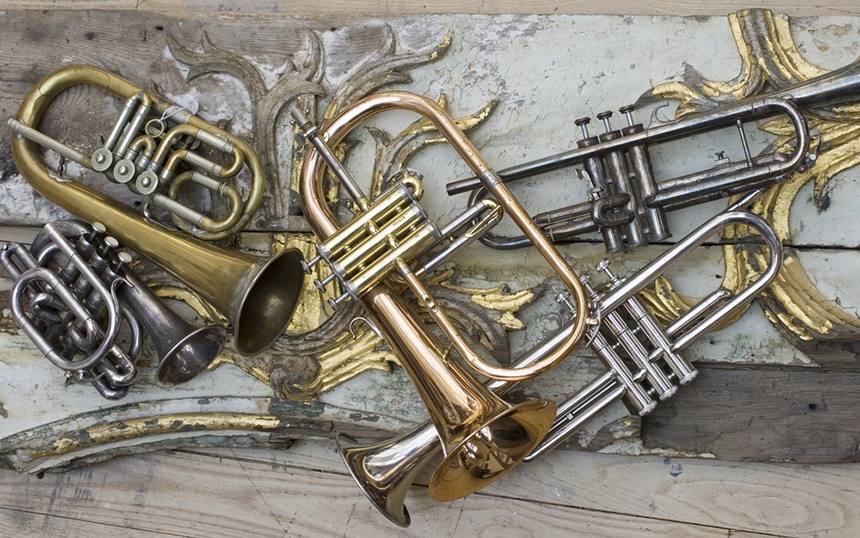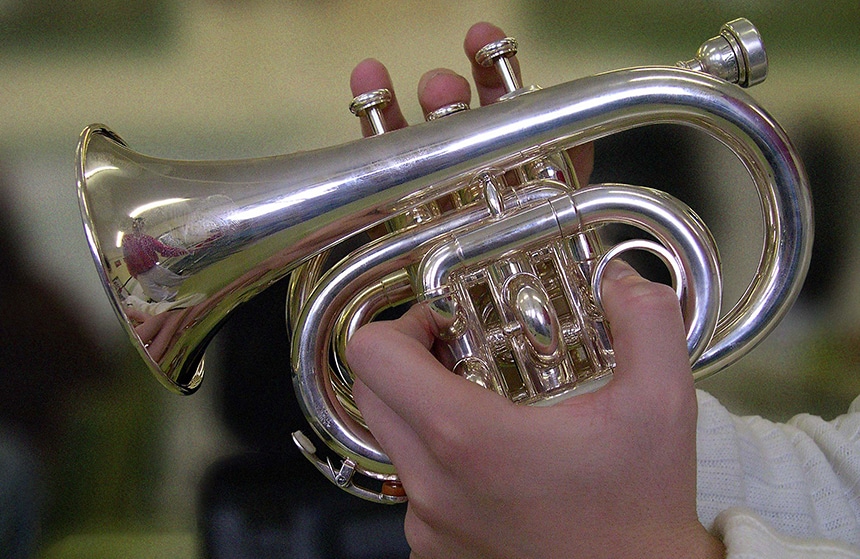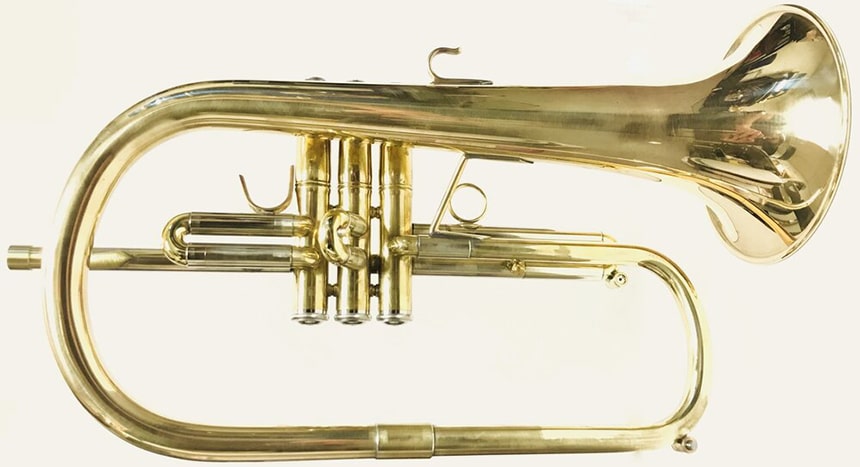Welcome to the wonderful world of trumpets! You might think trumpets are a simple instrument, but there are actually a lot of variations and a lot to know about each variation. The trumpets covered in this guide include:

The first known metal trumpets can be traced as far back as 1500BC. Silver and bronze trumpets were found in the grave of King Tut. Before that, people would blow into animal horns or conch shells to make sounds. Humans have been making music and sounds for as long as we have existed.
Ancient trumpets weren’t used to make music. Rather, they were used for military reasons or religious ceremonies. Trumpet players in medieval times were greatly guarded in war since they were so important to relaying information to soldiers.
The Bb trumpet Trusted Source Trumpet - Wikipedia The trumpet is a brass instrument commonly used in classical and jazz ensembles. The trumpet group ranges from the piccolo trumpet with the highest register in the brass family, to the bass trumpet, which is pitched one octave below the standard B♭ or C Trumpet. en.wikipedia.org is the most common trumpet worldwide. Why is it called the Bb trumpet? When you play a C on your trumpet, it actually makes a Bb note in “concert pitch.” Instruments like the piano, flute, oboe, and stringed instruments play at concert pitch. That means when they play a C, it actually is a C in concert pitch.
The reason the Bb trumpet exists is that the fingering for concert pitch Bb is much simpler than the fingering for concert pitch C! Each piece of music is adjusted in key so that when all the instruments play together, they’re playing the same notes.
Although it has a small size, the average trumpet can have up to six and a half feet of tubing.
If you want to start playing the trumpet, the Bb trumpet is the best place to start, and this guide can help you pick out the perfect instrument. This is another great option.
The C trumpet is the second most popular kind of trumpet. The C trumpet has a brighter tone than the Bb trumpet, which is more mellow.
The fingerings on the Bb and C trumpet are the same, so if you know how to play a Bb trumpet, you know how to play a C trumpet! The C trumpet is in concert pitch, so when you play a C on a C trumpet, it is actually a C in concert pitch.
The C trumpet is a lot smaller than the Bb trumpet, which gives it a concert pitch and a bright sound.
D/Eb trumpets are even smaller and brighter than C trumpets. They sound very different from the Bb trumpet and are brighter and tinnier. Certain orchestral pieces and solo pieces are played on the D/Eb trumpet, like the Haydn Trumpet Concerto in Eb. A lot of D/Eb trumpets have interchangeable slides and different bells to change keys. The D/Eb trumpet gained popularity in the 1860s to perform Baroque music. Some composers wrote music specifically for this trumpet because they wanted its unique bright sound.
The piccolo trumpet is the smallest of all trumpets. The piccolo trumpet is usually pitched in Bb, an entire octave above the Bb trumpet. They have a lead pipe extension that can turn the key from Bb to A. They have a fourth valve, which expands the range down to a low F#. The piccolo was famously featured in Penny Lane by The Beatles. Baroque music that was originally written for D/Eb trumpets is now played on piccolo trumpets. If the uniqueness of the piccolo trumpet sparks your interest, here’s a list of five great piccolo trumpets to choose from.

The pocket trumpet is a Bb trumpet with tubing that is more tightly wound, which makes the instrument smaller. But it still plays the same notes and octaves as a normal Bb trumpet. It is not typically played in a concert band or orchestra. It is sometimes used by jazz soloists.
The most famous example of a pocket trumpet is Don Cherry’s playing with the Ornette Coleman quartet. The idea to reduce brass instrument size while maintaining tube length can be traced back to the 19th-century cornets. Pocket cornets have been produced since the 1870s.
Bebje and Kanstul are two American manufacturers of the pocket trumpet. Primesound has compiled a list of six amazing pocket trumpets. If you want one specifically in Bb, this is another choice you can’t go wrong with.
The natural trumpet is valveless. That means the notes aren’t produced with fingerings. Instead, they are produced by manipulating the mouth of the player to create higher and lower pitches. The shape and pressure of the mouth are called the embouchure.
The natural trumpet traces back as early as the 16th century. It was also used by the military to communicate break camp, retreats, and other things.
Something unique about the natural trumpet is that it can produce notes outside of the typical C scale. These notes are flat or sharp and off-key but can add flare to a song when used very carefully. It takes a lot of skill to play the natural trumpet since every note is being played by ear. Living players include Don Smithers and Jean-Francois Medeuf.
The bugle is used as a military signaling instrument today. It dates back to the 1750s.
The early bugle was pitched in C or D and could be lowered to B by adding a piece of tubing you could attach to the instrument. This made it longer, which lowered the pitch.
Around 1800 it became looped once around into a trumpet shape. The British designed it to be wrapped twice around in the late 1850s.
Bugle calls use the second and sixth notes of a scale. There are three groups of calls: regimental calls, field calls, and routine calls. You may recognize the reveille and the last post, which have been around since 1815. Most calls used to be played at a lower pitch than they are today. Valves were added to the instrument, which evolved into the baritone and euphonium.
The slide trumpet has a slide, similar to the trombone. It evolved into the modern-day trombone. The main difference between the two instruments is that the slide trumpet has one slide joint, while a trombone has two. Due to this evolution, the slide trumpet is also referred to as a soprano trombone.
The slide trumpet came out of Western and Central Europe. It was used as a dance instrument instead of a war instrument. The slide trumpet was the first trumpet that wasn’t used for war.
The slide positions are close together, so it is hard to play. Since there are no valves, the notes are changed by moving the slide and adjusting the player’s embouchure.
A good way to train your ear to play the slide trumpet is to find the chromatic half steps within the slide.

The Flugelhorn is classified as a wind, brass, and aerophone instrument. Most flugelhorns are pitched in Bb, while others are pitched in C. It is a kind of valved bugle. It evolved from the valveless English bugle in Germany in the early 19th century. The first valved bugle was sold in Berlin in 1828.
The Flugelhorn inspired the Adolphe sax, the inventor of the saxophone, to invent his Bb soprano saxhorn. In the early 1700s in Germany, a hunt leader, otherwise called a Flugelmeister, blew the Flugelhorn to direct the hunt. Most flugelhorns have three piston valves, but four-valve variants exist as well. This lowers the pitch and adds a lower range.
The mouthpiece of the Flugelhorn is more conical than that of the trumpet or cornet. The sound of a flugelhorn is mellow and dark. It is hard to control in the high register but is easy to control in lower registers. It is used a lot in jazz, and sometimes in orchestras or concert bands.
The cornet is similar to the trumpet but stands out because of its conical bore, which is the interior chamber of the instrument. It is also different because it is more compact and has a mellower sound.
The most common cornet is in Bb, but there is also a soprano cornet in Eb, as well as cornets in A and C. The cornet evolved out of the post horn, which was a valveless, circular brass instrument. In the 1820s in France, people innovated by adding rotary valves to it. By the 1830s, people were making it with piston valves.
Cornets were first used in 19th-century French songwriting. For about 100 years, composers wrote separate parts for trumpets and cornets. The trumpet parts were more fanfare, which is a short flourish, and the cornet parts were more melodic. But now, the trumpet has the same notes and fingerings as the cornet.
Trumpets are a fascinating instrument. There is so much history behind them and so many different variations to learn about. They have evolved throughout history along with humanity.
No matter who you are, there is a trumpet out there for you! They all have a unique sound and a different way of playing. If you’re just starting out, the Bb trumpet is your best bet. But if you’re an experienced player, widen your horizons and try out some other options!
The pocket trumpet is great for travel and a fun novelty item to have on your wall. If you’re an antique collector, try to get your hands on an authentic older variation of the trumpet, like a posthorn or cornet!
Trumpets are popular in all different kinds of music. Listen to trumpet players like Miles Davis, Louis Armstrong, Chet Baker, and Dizzy Gillepsie. It’s impossible not to fall in love with the trumpet.
Flugel horns, bugles and cornets are not trumpets. They’re all similar but are classified under brass instead of being a type of trumpet.